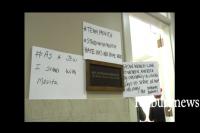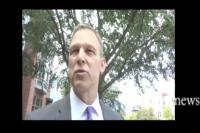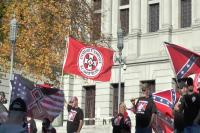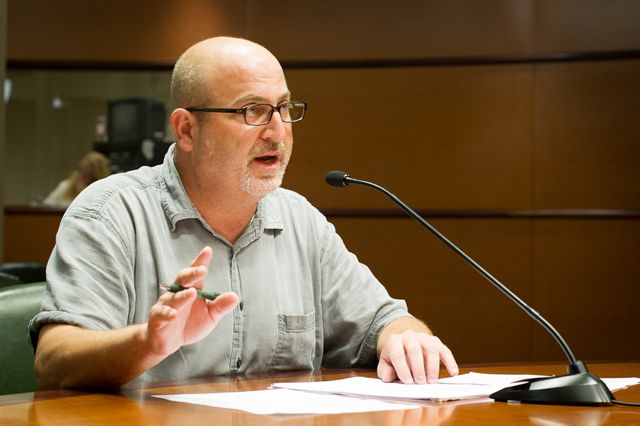Eric Epstein raises concerns about the cost and responsibility of cleaning up the Harrisburg Incinerator site if the facility is a "de facto" hazardous waste site. - Before the Dauphin County Commissioners Comments of Eric Epstein August 1, 2012 Beginning in 1987, I have documented noncompliance issues afflicting the Harrisburg Steam Generating Faculty (?HSGF?), renamed the Harrisburg Materials, Energy, Recycling and Resource Recovery Facility (?Facility?) in 1992. The Harrisburg Steam Generating Facility generated ash residue from the incineration of household municipal waste and non- hazardous industrial solid waste. By March 11, 1974, two years after the facility began operation, Site A was filled beyond capacity. Six years later, on January 10, 1980, the Office of Attorney General (?AG?) filed an Equity Complaint with the Commonwealth Court against the City of Harrisburg. The AG ?alleged? the HSGF continued to deposit incinerator residue at Site A and failed to have Site B properly prepared. On September 12, 1978, DER issued Permit No. 100992 to the City of Harrisburg for the operation of Pit B-1. Over five years later, on July 10, 1985, the Pennsylvania Department of Resources (?DER?) notified the City of Harrisburg. ?The existing condition of residue disposal Sites A and B-1 causes concern for the potential impact on human health and the environment.? In addition, on February 4, 1986 Swatara Township complained to the DER about severe rodent infestation at the facility. The fly, bottom, and combined ash streams generated by the HSGF during the years 1985 and 1987 was technically and legally classified as "hazardous" waste under the EP toxicity test used by the Environmental Protection Agency (?EPA?) and the DER to determine the hazardousness of waste. The HSGF disposed of the ash in onsite pits designated Pit A and Pit B Neither pit was qualified to receive hazardous waste. On June 27, 1986, the DER issued a Notice of Violation (NOV) for the City?s failure to close Site A and maintain a leachate collection system. Similarly, Site B was issued a NOV for filling B-1 (?Mt. Ashmore?) beyond capacity and failing to maintain a leachate treatment system or diversion channel. The City of Harrisburg replied on August 17, 1986: ?The reality and economics of the situation are such that it will be virtually impossible to remove all the ash from both sites to the originally permitted levels.? Finally, on December 20, 1988, the City agreed to close Site A by March 15, 1989, (15 years after the pit was full), and pay a $25,000 penalty. The ash residue analysis conducted by Skelly and Loy on September 28, 1987 supported the contention that the ash residing in Pit A and B-1 is hazardous. DER conducted ash residue analysis on May 23, 1985 and August 8, 1985 which concluded that the ash residing in Pit A and B-1 is hazardous. The City of Harrisburg did not dispose of the hazardous ash in a "hazardous" waste landfill. The HSGF claimed' an exemption to hazardous treatment for the ash residue allegedly found in the Solid Waste Management Act is identical to the language in the Resource Conservation and Recovery Act (RCRA). (1) The United Supreme Supreme Court ruled that the ash residue from resource recovery facilities is not exempt from the requirement that solid waste classified as 'hazardous' requires disposal according to the Resource Conservation and Recovery Act's Subtitle C regulation (governing handling of hazardous wastes). Therefore, the hazardous ash residue remaining in Pits A and B-1 should be disposed of accordance with hazardous waste regulations. _____ 1 In a 7-2 ruling in Environmental Defense Fund v. City of Chicago on May 2, 1994 the Supreme Court interpreted this identical language of the claimed exemption to specifically not include ash residue that, but for the claimed exemption, would be classified as ?'hazardous.? The City of Harrisburg, in its capacity as owner of the HSGF, filed an amicus brief supporting the City of Chicago which incinerator hazardous waste was not not hazardous waste because it came from an incinerator. Pit A was consistently filled beyond capacity, built with a rubber liner and had a history of groundwater contamination and soil erosion Pit B-1 was also filled beyond capacity, used a PVC liner and had a history of noncompliance in conducting groundwater monitoring leachate collection for treatment. Questions and outstanding issues for Dauphin County: 1) Have these legacy environmental issues identified over 30 years at Pit-A and Pit-B been fully and completely remediated? If so, does the County posses the manifests and where can citizens obtain the documentation, and current status of environmental and groundwater monitoring? 2) The facility is a de facto hazardous waste site. Who or what is ultimately liable and responsible for maintaining, monitoring and remediating any future cleanup? Does the chain of custody end with City residents or County taxpayers? 3) The reuse value as well as the taxable value of this property is linked to the cleanup standard. Will this 20 acre property be cleaned up to a Brownfield or Greenfield standard? 4) Is there an external, segregated funding mechanism in place to ensure the cleanup of Harrisburg Materials, Energy, Recycling and Resource Recovery Facility is implemented? How much is in the fund and who controls it? Are the investment or withdraw limitations? Tags: eric epstein, harrisburg incinerator, hazardous waste site. Photo/Natalie Cake
- Home
-
Local
 Dauphin County Election Board - May 8, 2024
Dauphin County Election Board - May 8, 2024 Harrisburg University Tax-exempt bonds not to exceed $100 Million.
Harrisburg University Tax-exempt bonds not to exceed $100 Million.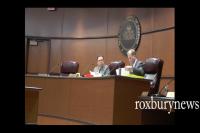 Dauphin County Commissioners Meeting February 13, 2019
Dauphin County Commissioners Meeting February 13, 2019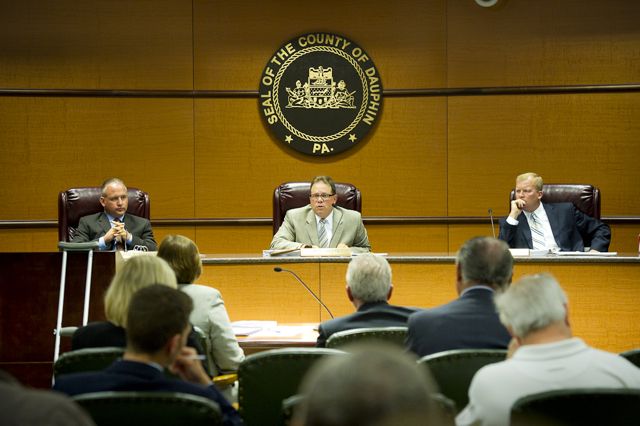 Dauphin County Commissioners Meeting February 13, 2019
Dauphin County Commissioners Meeting February 13, 2019 Modified Harrisburg Strong Plan Presented to Judge Bonnie Leadbetter for approval in Commonwealth Court on Thursday, September 19th, 2013.
Modified Harrisburg Strong Plan Presented to Judge Bonnie Leadbetter for approval in Commonwealth Court on Thursday, September 19th, 2013.
- State
- National
- Entertainment
-
Featured
 PA Senate Local Government Committee: Testimony of Carol Cocheres, Esquire
PA Senate Local Government Committee: Testimony of Carol Cocheres, Esquire PA Senate Local Government Committee: Testimony of James Losty of RBC Capital Markets
PA Senate Local Government Committee: Testimony of James Losty of RBC Capital Markets PA Senate Local Government Committee: Testimony of David Unkovic, former Receiver of the City of Harrisburg
PA Senate Local Government Committee: Testimony of David Unkovic, former Receiver of the City of Harrisburg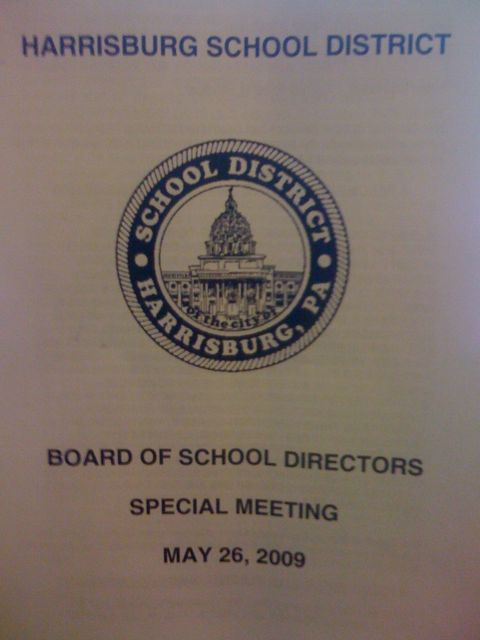 Bruce Barnes of Milt Lopus & Carol Cocheres of Eckert Seamans - A financing package of $280 million plus.
Bruce Barnes of Milt Lopus & Carol Cocheres of Eckert Seamans - A financing package of $280 million plus. Special Report: Forensic Audit - Bruce Barnes presents. July 7, 2007. (Part 3)
Special Report: Forensic Audit - Bruce Barnes presents. July 7, 2007. (Part 3)
-
Election
 Pa State Rep. Bryan Cutler - December 1st 2022
Pa State Rep. Bryan Cutler - December 1st 2022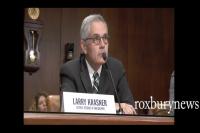 The Impeachment of DA Larry Krasner
The Impeachment of DA Larry Krasner The Special Master recommends that Fulton County be adjudged in civil contempt of the Injunction Order.
The Special Master recommends that Fulton County be adjudged in civil contempt of the Injunction Order. Archive Video - Abby Abildness Jericho March Harrisburg November 14th 2020
Archive Video - Abby Abildness Jericho March Harrisburg November 14th 2020 Archive Video - Proclamation of Penn's Quotes July 1, 2022
Archive Video - Proclamation of Penn's Quotes July 1, 2022 Philadelphia DA Larry Krasner - Articles of Impeachment
Philadelphia DA Larry Krasner - Articles of Impeachment Jericho March November 8, 2020
Jericho March November 8, 2020 Doug Mastriano - Chambersburg Pa 9.16.22
Doug Mastriano - Chambersburg Pa 9.16.22 ReOpen Pa Rally - April 20, 2020
ReOpen Pa Rally - April 20, 2020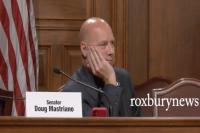 Doug Mastriano - Freedom Rally Capitol steps June 5th 2021
Doug Mastriano - Freedom Rally Capitol steps June 5th 2021
-
Join / Log In
-
Sign up by e-mail , with or
-


